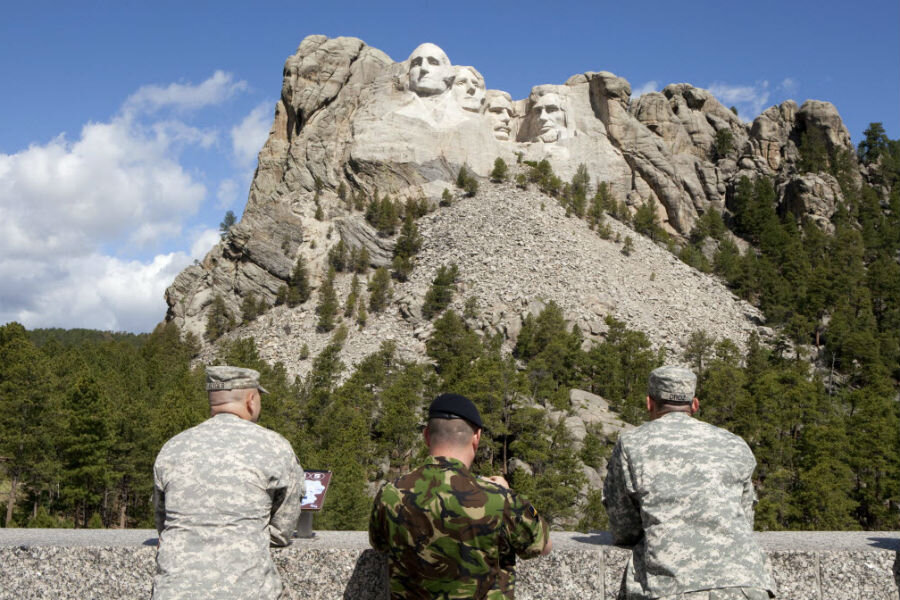Parks for the people: How the National Park Service is celebrating Presidents’ Day
As the nation celebrates Presidents’ Day, the National Park Service is taking the opportunity to showcase what the late writer Wallace Stegner once described as America’s best idea: national parks.
On Monday, national parks across the country will be open to the public for free. It’s one of 10 fee-free days that celebrate important events such as Veterans’ Day and the birthday of the National Park Service. President-themed events abound: Valley Forge National Historical Park in Pennsylvania is celebrating George Washington’s birthday, while at Jimmy Carter National Historical Site in Plains, Ga., the former president himself will share his thoughts about the Camp David Accords. At South Dakota’s Mount Rushmore, where US presidential history is literally carved in stone, a special concert will be held.
Making the parks free for Presidents’ Day is intended to encourage all Americans to use the parks, which symbolize the best of the nation's history, geography, and leadership. It’s a demonstration of the values that the National Park Service embodies, even in the face of challenges such as overcrowding and limited budgets.
“Every person to hold the office of president of the United States is represented in our national parks through historic homes, places of significant national events, national monument designations, conservation areas, and more,” acting National Park Service director Michael Reynolds said in a statement. “We invite everyone to reflect on the role of presidents in a park this weekend.”
Presidents’ Day began its life as a celebration of the first US president, George Washington. More than four decades after festivities to mark the centennial of his birth on Feb. 22, 1832, the date finally became a federal holiday in 1879. Washington’s Birthday was celebrated on that day until 1968, when the Monday Holiday Law – intended to improve the efficiency of businesses and create more three-day weekends – stipulated that it should be celebrated on the third Monday in February. The move created an opening for marketers, who billed the long weekend as a “Presidents’ Day” celebration, and the name was widely adopted by states, which began to celebrate local heroes as well as national ones. Abraham Lincoln's birthday on Feb. 12, which is observed as a holiday in eight US states, has also been incorporated into President's Day celebrations.
For the National Park Service, Presidents’ Day is also a marketing opportunity, albeit of a different sort. It’s an opportunity to highlight the importance of preserving parks, which represent the rich variety and history of the United States.
“Parks provide opportunities in times of great sorrow and despair to reenergize the American spirit and bring people together,” David Vela, the superintendent of Grand Teton National Park, told The Christian Science Monitor’s Todd Wilkinson in July, noting that Americans sought to connect with national parks in increasing numbers after 9/11.
That spirit is very much alive today, as the record numbers of visitors in 2016 seems to suggest. And the free days help share it with those who may not usually think to visit the parks.
But visitors may also strain park infrastructure beyond its capacity. Already, there have been questions about whether heavy traffic is causing permanent damage to Yellowstone National Park. In 2015, there was nearly $12 billion in necessary infrastructure upgrades that had been delayed for more than a year, a challenge tight budgets have intensified.
With substantial effort, the transformative power of the parks can be preserved, advocacy organizations suggest. And Presidents’ Day may be a chance to harness Americans’ enthusiasm for the parks. Asked about the presidential candidates before the 2016 election, nearly 90 percent of voters surveyed indicated that candidates who prioritized the parks were seen as patriotic and good stewards of the nation, suggesting that fitness for the presidency may be bound up with a commitment to preservation.
“Parks are an important way to protect our common heritage so generations to come can enjoy these remaining pieces of the Earth that seem lost in time,” Emma Brawn, a veterinarian from Ohio, told the Monitor in July.







